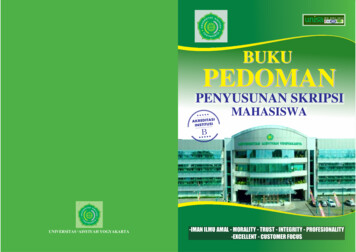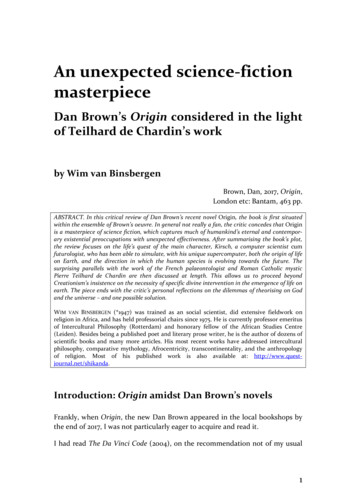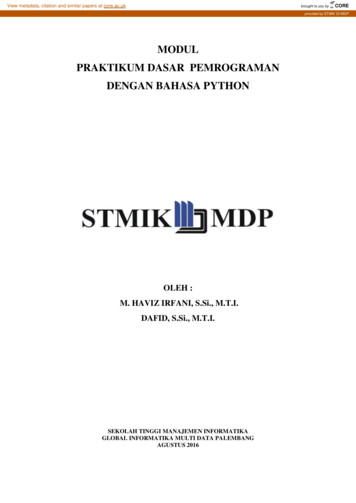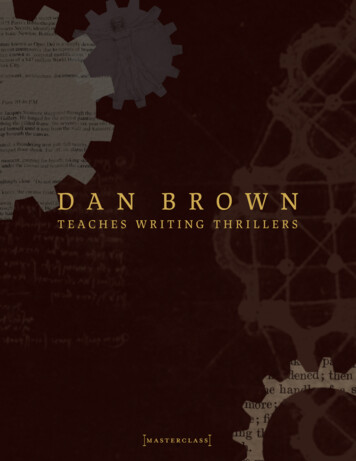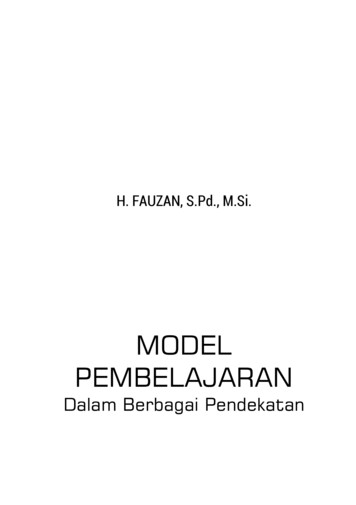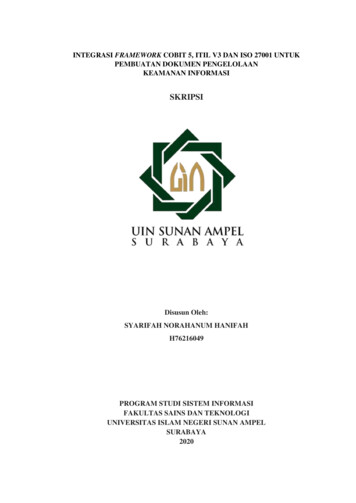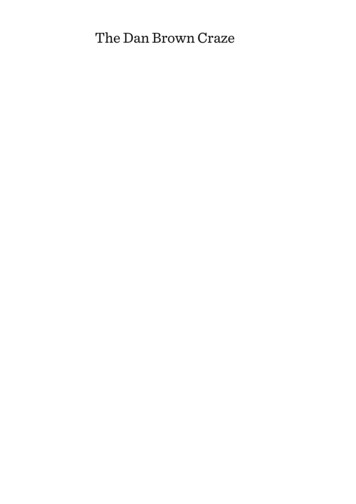
Transcription
The Dan Brown Craze
The Dan Brown Craze:An Analysis of His Formulafor Thriller FictionByZhenwu Zhu and Aiping Zhang
The Dan Brown Craze: An Analysis of His Formula for Thriller FictionBy Zhenwu Zhu and Aiping ZhangThis book first published 2016Cambridge Scholars PublishingLady Stephenson Library, Newcastle upon Tyne, NE6 2PA, UKBritish Library Cataloguing in Publication DataA catalogue record for this book is available from the British LibraryCopyright 2016 by Zhenwu Zhu and Aiping ZhangAll rights for this book reserved. No part of this book may be reproduced,stored in a retrieval system, or transmitted, in any form or by any means,electronic, mechanical, photocopying, recording or otherwise, withoutthe prior permission of the copyright owner.ISBN (10): 1-4438-9026-XISBN (13): 978-1-4438-9026-7
TABLE OF CONTENTSAcknowledgments . viIntroduction . 1Chapter One . .21Brown’s Journey to FameChapter Two . 52Decrypting the Key for Digital FortressChapter Three . 97Defining Angels and DemonsChapter Four . 160Exposing Deception PointChapter Five . 209Breaking The Da Vinci CodeChapter Six . 273Searching for The Lost SymbolChapter Seven. 327Discovering InfernoBibliography . 378Index . 386
ACKNOWLEDGMENTSThis book is the product of several years’ worth of brainstorming anddevelopment. The original idea for a book-length study on Dan Brownfirst occurred to Zhenwu Zhu when his Chinese translation of The DaVinci Code became a huge hit and instantly brought the “Dan BrownCraze” to China in 2004. As he started his translation of Brown’s earlynovels in the following years, this idea turned into a strong desire.In 2010, during Aiping Zhang’s lecture tour at Shanghai University,we had a series of conversations about the new developments in thecontemporary American novel, including the “Dan Brown Craze” that wasquickly spreading around the world. To our pleasant surprise, wediscovered that we both had a keen interest in Brown’s innovative thrillerfiction and its mesmerizing impact upon his readers in the West as well ashis non-English-speaking readers in China. We thought that acomprehensive study of all the novels that Brown had published so farwould be a valuable contribution to the international criticism of Brown’swriting. Our hope was to write a book that would not only offer richinformation and a luminous analysis on the wide range of subjects coveredin Brown’s novels but also show readers and scholars around the worldhow Brown’s thriller fiction had been appreciated and studied in China.The authors could not have gotten anywhere on this project withoutadvice and help from so many people. First, we would like to thank theeditor and publisher at the People’s Literature Press in Beijing, China fortheir permission to use some of Zhu's Chinese writings in Decoding DanBrown. Also, many scholars, colleagues and friends at ShanghaiUniversity in China and California State University, Chico in the UnitedStates have helped us complete the book. They gave us much more thanmerely intellectual assistance: they offered valuable comments, excellentsuggestions and unflagging encouragement. Zhu is especially grateful toLi Li at the Chinese University of Hong Kong, You Wu and Limei Yuanat Shanghai University, Dan Li at the Zhejiang University of Industry andCommerce, Yu Guo at Fudan University, and graduate students,particularly Hongying Dong, Jitao Sun, Xiaomeng Chen, Xiujuan Xie, andYi Zhang, for their enthusiasm and early assistance in research. Zhangwould like to give special thanks to the College of Humanities and FineArts at CSU, Chico for the benefit of a research grant, and to SharonDeMeyer for her thoughtful support and her untiring effort to minimize
The Dan Brown Crazeviiunexpected distractions when he was working on the project in the chair’soffice.We have also benefited immeasurably from Anthony Wright, VictoriaCarruthers, and Amanda Millar, the highly capable and professionalediting team at Cambridge Scholars Publishing. Their wise suggestions,precise instructions and incredible patience are greatly appreciated.Without their encouragement and expertise, it would have been impossibleto bring this book to fruition.Finally, we are extremely grateful to our families. We can find nowords adequate to express our gratitude for their sustained understanding,support and so much more.
INTRODUCTIONIn early March 2003, the world of fiction was ruled by one author,J.K. Rowling. The most well-known character in fiction was a youngspectacled boy, Harry Potter, and the most coveted work was the longrunning series of fantasy novels, Harry Potter. While millions of HarryPotter fans had been waiting anxiously for the release of the fifth novel inthe series ever since the fourth one came out in July 2000, in Exeter, NewHampshire, Dan Brown, the writer of two humor books and three novels,was nervously waiting for the release of his fourth novel. He had come upwith his own series of thriller fiction filled with codes, mysteries, andexciting settings, but his first try, Angels & Demons, did not get off to apromising start in 2000. The following novel, Deception Point, publishedin 2001, did not do well, either. The income from the sale of his novelswas barely enough to keep his writing career afloat.“The Da Vinci Code Phenomenon”On March 18, 2003, the release of The Da Vinci Code, his fourthnovel and the second one in his “Robert Langdon Series”, quickly changedeverything. Certainly he had hoped for a big break in his writing career butit was beyond his wildest dreams that the novel would become an instanthit and take the world of fiction by storm. Within just a week or two, heand his novel had caught the attention of numerous book reviewers, criticsand, more importantly, millions of readers. The novel climbed to the topof The New York Times bestseller list during the first week and dominatedthe list for more than two years until November 2005. For months, Brownappeared on numerous TV and radio shows, his photo appeared on thecover of dozens of magazines, hundreds of newspapers and websitescarried reviews of his books, and his fiction was the hottest subject ofdebate on social media.Many critics and scholars of Brown, including J.B. Hixson, used thephrase “The Da Vinci Code Phenomenon” to describe the sensationalsuccess and widespread response that the novel generated after its release.11J.B. Hixson, “The Da Vinci Code Phenomenon: A Brief Overview andResponse,” Journal of the Grace Evangelical Society 17.33 (Autumn, 2004): 41.
2IntroductionIt is a fitting characterization of the tremendous impact of Brown’s booksince a slew of impressive statistics reinforces the claim: millions ofcopies were sold within a few months, hundreds of book reviews werepublished through various media outlets, and numerous translations of thebook became available throughout the world. Within a year or two, dozensof books came out, cracking Brown’s codes, scrutinizing his errors,exposing his distortions of history, dismantling his mysteries, or refutinghis assumptions altogether. Despite harsh criticism from many reviewersand vehement protests from various organizations, millions of readers feltunsatisfied after reading The Da Vinci Code so they went back to Brown’sprevious novels for more exciting coding, suspense, and action. Soon, hisfirst three novels, published before 2003, had to be reprinted to meet thesurging demand and all appeared on the bestseller list, one after another.In his review of Brown’s The Da Vinci Code for The Telegraph, MichaelDeacon writes, in a tongue-in-cheek manner, “His books were read byeveryone from renowned politician President Obama to renownedmusician Britney Spears. It was said that a copy of The Da Vinci Code hadeven found its way into the hands of renowned monarch the Queen.”1Before long, “The Da Vinci Code Phenomenon” had turned into a bonafide “Dan Brown Craze” around the world.The “Dan Brown Craze”No other book or author in America has generated both success andcontroversy at such magnitude in recent decades. Readers and scholarscannot help wondering why The Da Vinci Code “has become more than anovel.”2 Timing was certainly one of the key factors. We remember wellthat the months preceding March 2003 were not easy for America and theworld. At home, America was still reeling from the 9/11 tragedy andtrying to adapt to a new way of living, with less liberty but more fearunder the unpredictable threat of terror. While the war in Afghanistan wasdragging on, another war with a much more formidable foe, Iraq, seemedinevitable and imminent. Abroad, an outbreak of Severe AcuteRespiratory Syndrome (SARS) was raging in Asia, taking many livesthere and posing a potential risk elsewhere. People desperately wanted toknow what was happening in their life and where the world was headingnext.1Michael Deacon, “Don’t Make Fun of Renowned Dan Brown,” The Telegraph,May 10, 2013.2Bradley Bowers, ed., The Da Vinci Code in the Academy (Newcastle, UK:Cambridge Scholars Publishing, 2007), vii.
The Dan Brown Craze3Due to the growing dominance of the Internet and social media, andthe revolutionary changes in education, communication, and disseminationof knowledge they engendered, the publishing industry was in a deepslump and interest in book reading was diminishing. True, the HarryPotter series filled a void and presented readers, old and young, with apleasant surprise every couple of years. However, readers needed morethan one juvenile fantasy novel series. They wanted something that wouldnot only validate what they had learned and cherished in the past, such ashistory, art, and religion, but also resonate with what they had to cope withat present. Bradley Bowers puts it well:It is not about Brown, the novel, or Leonardo da Vinci. It is the rekindlingof desire, desire to reconnect with the divine in a world which has beenrobbed of divine secrets and stripped of divine codes, a world whichcontinues to erase the wisdom of the ancients, and which denies that ourstories can contain truth, even a glimpse of it.1For many, reading Brown’s novels, which were consistently writtenwith a formula of mysteries mixed with historical wonders and realisticissues, is like discovering “alternative texts” that “may exist and may haveas much, even greater, authority than the standard versions.”2 Moreimportantly, readers have found Brown’s novels both thought-provokingand entertaining because, on the one hand, they enlighten readers bytransmitting knowledge about a wide range of subjects that connect historyand reality, and they delight through fascinating discoveries and endlessthrills on the other.It should be pointed out, though, that the “Dan Brown Craze” is by nomeans a chorus of praise for the author. Since the week his book appearedon the bestseller list, Brown has been a frequent target for harsh criticismand scathing ridicule. In his review on Inferno for The Telegraph, MichaelDeacon notes, “The critics said his writing was clumsy, ungrammatical,repetitive and repetitive. They said it was full of unnecessary tautology.They said his prose was swamped in a sea of mixed metaphors.”3 Manyscholars believe that his novels are potboilers of historical anecdotes ormysteries and, therefore, belong to the low-brow popular novel category.A more contentious charge has come from Christian scholars and religiousleaders, who regard Brown’s thriller fiction as outrageous heresy againstChristianity. As Eric Spitznagel observes, however, “The louder the critics1Ibid, vii.Ibid, viii.3Michael Deacon, “Don’t Make Fun of Renowned Dan Brown,” The Telegraph,May 10, 2013.2
4Introductiondeclare his mediocrity, the more books he sells.”1 More than ten yearslater, the “Dan Brown Craze” still shows no sign of abating. Theblockbuster movies adapted from two of the “Robert Langdon Series”novels, Angels & Demons and The Da Vinci Code, have certainly helpedto keep its momentum going. After all, Brown’s novels have already soldclose to 200 million copies globally. “No one can be that successfulwithout doing something right.”2Brown’s Secrets for SuccessOne question that Brown often has to answer in interviews is whetherhe has a secret formula for writing bestselling novels, or for his phenomenalsuccess as a novelist. Naturally, he is always a bit coy, evasive, ordiplomatic in answering. He has said that he wished he did have a workingformula so he could write faster and produce more novels. An observantreader can certainly see the similar elements – codes, symbols, andlocations – in his first six novels and the innovative way he has mixedthem together seamlessly for maximum effect.It has been widely acknowledged that each of Brown’s novels notonly covers a wide range of subjects, such as history, art, literature,religion, and science, but also connects them to long-standing mysteriesand sensitive issues in today’s world. As many of the incidents andcontroversies featured in his novels are either well-documented or havebeen frequently debated over the years, or even centuries, the toughchallenge for Brown is to be able to collect data and disseminate them inhis narrative both accurately and forcefully. Brown has frequently claimedin interviews that he is a writer who values research. For him, the first stepis always a ritual of indefatigable search for information. Once the outlinefor his novel is basically set, his research starts on different frontssimultaneously, such as posting questions on the Internet, consultinglibrarians and experts in different fields, checking numerous books fordetails, scouting sites, cities, and countries for the selection of settings,and spending long hours in museums and libraries to verify his sources.During his second “Question & Answer” session on Facebook in May2014, someone asked him, “How many times have you been to theLouvre?” Brown answered with a smile, “Never enough!”31Eric Spitznagel, “Books: Five Business Lessons from 'Inferno' Author DanBrown,” The Bloomberg Businessweek, May 15, 2013.2Ibid.3The Official Website of Dan Brown, accessed August 5, 2014.http://www.danbrown.com
The Dan Brown Craze5Over the years, he has counted on two reliable sources for assistanceand support: one is his dedicated and resourceful wife, Blythe; the other ishis circle of “expert” friends. Thanks to his growing popularity since thepublication of The Da Vinci Code, he has easy access to more sources ofinformation than before. Unlike other writers, Brown shows his confidenceabout the accuracy of the details in his work by placing a fact note at thebeginning of all the novels in the “Robert Langdon Series”, claiming thatall references, organizations, and incidents are factual.What is also essential to his success is his determination to strive foran organic textual construction of meaning, value, and excitement. Hesays that he writes novels that are designed not only to be “entertainingand fun to read, but also to inspire intellectual curiosity on topics that Ifind interesting.”1 His novels are full of elements of history, science, art,religion, anecdote, and mystery. He seldom, if ever, relies on simplecitation. Instead, he prefers to revise, deconstruct, and even subvert hismaterials in order to facilitate what Renjing Yang called “the fusion ofhistory and imagination”2 and offer his readers a refreshing and enlighteningreading experience. The “Robert Langdon Series”, which includes Angels& Demons, The Da Vinci Code, The Lost Symbol, and Inferno, is a perfectcombination of religion, suspense, art, and excitement, while DigitalFortress and Deception Point address the inevitable clash between hightechnology and political maneuvering in today’s world. His stories mightbe entangled with ancient history, obscure works of art, or mysteriouslegends but they are always related to the real issues we all face in life.Even his harsh critics, like Robert Price, have praised the good qualities inBrown’s writing style:Its brisk narrative is full of twists and turns, and the reader’s perseveranceis frequently rewarded with deft turns of phrase, sparkling metaphors, andresonating observations, the stock in trade of an author who can show usnot only what we did not know but also what we did know but were notaware of knowing.3The ambiguity of Brown’s mystery-filled narrative has been afrequent subject of controversy. The critics see it as a result of his shakyreferences or troubling claims that cannot be substantiated by concrete1Bob Minzesheimer, “Dante’s Inferno Inspired Dan Brown’s Inferno,” USAToday, May 14, 2013.2Renjing Yang, The Theory of Postmodern American Novel (Qingdao: QingdaoPublishing House, 2004), 98.3Robert T. Price, The Leonardo de Vinci Fraud: Why the Truth Is Stranger thanFiction (Amherst, New York: Prometheus Books, 2005), 12.
6Introductionfacts. In his view, however, ambiguity contributes tremendously to thesuccess of his novel writing. If placed strategically, ambiguity canfunction as an effective measure to reveal different sides of the issue andcreate ample space for the reader’s imagination. As a writer of thrillerfiction, Brown usually does not like to give all the answers; instead, hetries to invoke opposing views and let his readers draw their ownconclusions. He is more interested in exploring the paradoxical nature ofintriguing and contentious issues that have been debated throughouthistory. His use of ambiguity attracts more attention because it often leadsto a more paradoxical assumption of the theme or makes the premise ofthe story much vaguer. In a way, it is quite similar to a common practice inpostmodernist fiction. As Randall Stevenson points out, “Postmodernismradically extends such uncertainty, often assuming reality – if it exists atall – to be quite unknowable, or inaccessible through a language growndetached from it.” This is because “in the postmodern world, nothing iscentral and everything seems paradoxical.”1Mary Klages offers a more specific definition of postmodernism whenshe says, “Postmodernism, like modernism, follows most of these sameideas, rejecting boundaries between high and low forms of art, rejectingrigid genre distinctions, emphasizing pastiche, parody, bricolage, irony,and playfulness.”2 What she says can be easily applied to the mainfeatures of Brown’s writing. Compared to his early work, Brown’s lasttwo novels, The Lost Symbol and Inferno, seem to have accomplishedmore by breaking away from the conventions in novel writing andbringing historical, cultural, and spiritual connotations into full play.Embedding thought-provoking issues about history, culture, and life in acode-filled, suspense-driven, and fun-oriented story is clearly Brown’screative move and a key factor in his unprecedented success. He hasproven himself a master of exploring different aspects of complex issuesby channeling the mysteries of art, culture, and history into his narrative.His approach is consistently sensible and objective rather than imposingand heavy handed.A case in point is his treatment of the age-long conflict betweenscience and religion. When asked about his view on the debate betweenscience and religion, Brown said that in many cases, science and religionmean the same thing to him. In his view, both are inquiries into divinity,1Randall Stevenson, Modernist Fiction: An Introduction (Louisville, KY:University of Kentucky Press, 1992), 196.2Mary Klages, Literary Theory: A Guide for the Perplexed (London: A&C Black,2006), 165.
The Dan Brown Craze7and what sets them apart is that “religion focuses on the question itself,while science concerns itself with the search for the answer. Science andreligion use two different languages to tell the same story,” and his booksare a “quest to fuse those two worlds.”1Controversies over Brown’s NovelsTo understand the phenomenal appeal and true value of Brown’snovels, it is imperative to look into two things – his innovative writingstyle and all the controversies he has generated. It is no exaggeration tosay that controversy has followed him around since The Da Vinci Codeearned him the title of the most popular novelist in America. As RobertPrice notes, “Every time a book like Dan Brown’s The Da Vinci Codemakes waves in the religious public, one can be sure it will call forth a raftof books trying to refute it.”2 But Brown seems to have taken criticism inhis stride.At first, some critics suspected wayward borrowing from other novelsthat had been published earlier. For instance, soon after his The Da VinciCode came out, Brown was accused of picking up some ideas from a 1983novel by Lewis Perdue, in which the term, the Da Vinci Codex, was usedseveral times. Perdue’s novel was republished as The Leonardo da VinciLegacy in 2004. Then, Brown was attacked for making “subversive”interpretations of Leonardo da Vinci’s Mona Lisa and The Last Supper.Many Christians found his interpretation of The Last Supper extremelydisturbing. His suggestion that instead of 13 men in the painting there are12 men and one woman, and his assumptions that Jesus Christ, theunearthly saint worshiped by people, resumed his human nature, marriedMary Magdalene whom he once saved, and probably had descendantswere strongly condemned. More seriously, as Rachel Wagner writes,“Critics of the novel deal quite explicitly with its implications for biblicalinterpretation, Christianity, and views about early Christian history. ManyChristian critics of the book see its purpose as sinister, intended to destroythe credibility of the Bible and of Christianity.”3 Not surprisingly,1Lauren Yarger, “Dan Brown Interviewed by NPR at Mark Twain House Benefit,”Publishers Weekly, June 16, 2014.2Robert Price, The Leonardo de Vinci Fraud: Why the Truth Is Stranger thanFiction, 11.3Rachel Wagner, “The ‘Scholar’s Code’: Biblical Interpretation, Postmodernism,and The Da Vinci Code,” in The Da Vinci Code in the Academy, ed. BradleyBowers (Newcastle, UK: Cambridge Scholars Publishing, 2007), 31.
8IntroductionBrown’s hint at Jesus Christ’s bloodline has been viewed by manytheologians and church leaders as an intolerable defiance.In the spring of 2014, however, an article by Jonathan Beasley, whichappeared on Harvard Divinity School’s website and was soon picked upby major media outlets, reported on a scientific test on a papyrus fragmentcontaining the words, “Jesus said to them, my wife.” It is an ancientdocument that has been analyzed by scholars from Harvard University,Columbia University and the Massachusetts Institute of Technology, all ofwhom declared it an authentic document. Even though it “does not in anyway provide evidence that the historical Jesus was married,” it affirms that“women who are mothers and wives can be disciples of Jesus – a topicthat was hotly debated in early Christianity.”1 The official website of DanBrown posted a report about this study and cited it as “the first-knownreference to a married Jesus Christ” and new scientific evidence that“further supports the premise of The Da Vinci Code.” In his address to asold-out gathering of writers in Portsmouth, New Hampshire, Brown said,“It is not up to me to address the controversies.” He admitted that hisnovel was “about big ideas, you can love them or hate them But we’reall talking about them, and that’s really the point.”2The “Dan Brown Craze” in ChinaBy contrast, Brown’s reception in China has been overwhelminglyfavorable since his The Da Vinci Code was translated into Chinese 12years ago. Since then, readers have swarmed to the bookstores every timea Chinese translation of his novels was released. The social media was fullof chat about the reading of Brown’s novels. Many bloggers describedhow they found it hard to put down Brown’s novels, and would finish thereading in one sitting. Scholars caught the tidal wave of the “Dan BrownCraze” every time, offering their commentaries on TV shows and othermedia outlets, and presenting their evaluation of Brown’s work throughbook reviews, articles and presentations at scholarly conferences. The onlydebate among the scholars has been focused on whether Brown’s work1Jonathan Beasley, “Testing Indicates ‘Gospel of Jesus' Wife’ Papyrus Fragmentto be Ancient,” Harvard Divinity School Website, April 10, 2014, accessed August5, be-ancient2BBC News, “Brown Plays down Code Controversy,” Entertainment, April 24,2006, accessed August 5, 754.stm
The Dan Brown Craze9should be defined as “serious” or “popular” American novel. But mostscholars prefer to regard Brown as a writer who has brilliantly blurred therigid line between the so-called “serious” and “popular” novels, or the“high-brow” and “low-brow” forms of novel writing, through his innovativefusion of somber themes, postmodernist techniques, and thrillingplayfulness.China did not catch up with the “The Da Vinci Code Phenomenon”until February 2004 when the Chinese translation of the novel hit thebookshelves in bookstores, but it wasted no time before riding the wave ofthe worldwide “Dan Brown Craze.” In the past 12 years, it seems fair tosay that China has been a large part of the ongoing worldwide “DanBrown Craze” as no country, other than America, can match China’scontribution to either book sales or scholarly studies.As soon as Zhenwu Zhu, a professor of American literature and theauthor of several academic books on William Faulkner and Edgar AllanPoe, read about the phenomenal success of The Da Vinci Code in theWest, he realized that the novel would surely become a hit in China aswell. He approached the Shanghai People’s Press, one of the leadingpublishers in China, with a tentative plan to introduce Brown to Chinesereaders. To his surprise, he did not even need to give any justificationbefore receiving its endorsement for his plan. The Press immediatelybegan the task of contacting Brown’s agency, and Zhu recruited a coupleof his colleagues as his co-translators. In early 2004, the Chinesetranslation of The Da Vinci Code came out. Three hundred thousandcopies were sold initially, and it ran 18 printings before the end of theyear. The release of the Chinese translation of Brown’s novel was sosuccessful that the People’s Literature Press in Beijing, the mostprestigious publisher in China, decided to take over all the translating andpublishing rights of Brown’s novels. It published the translation of DigitalFortress a few months later in the same year. As the sale of the first twotranslations shot up into the millions, the Press decided to bring all ofBrown’s novels to China. Hence, the translation of Angels & Demons waspublished in 2005, followed by Deception Point in 2006, The Lost Symbolin 2010, and Inferno in 2013. To this day, no one knows the exact numberof the total sale of Brown’s novels in China as it is considered a tradesecret by the Press, but the media claims that over 3 million copies of TheDa Vinci Code have been sold, and that his other novels have run manyadditional printings since their initial release.In a way, the “The Da Vinci Code Phenomenon” and the “Dan BrownCraze” occurred in China simultaneously and swept through the countryalmost overnight, creating many “firsts” in the history of Chinese
10Introductiontranslation of foreign books. Twenty years ago, Qian Xiao’s Chinesetranslation of James Joyce’s Ulysses caused a big stir but the enthusiasmwas primarily confined to the community of Chinese scholars and Joycefans. The sale of that book was less than 1 percent of the total of Brown’snovels, and fell into oblivion shortly afterwards. So far, no other foreignauthor has had all his novels translated into Chinese during his lifetime; noChinese translation of any foreign book has sold the same number ofcopies within a few years; no foreign author has been a hot topic forblogging by ordinary readers and a popular subject for scholarlypublications at the same time.Evidently, the sale of Brown’s books has easily broken all the recordsof Chinese translation of foreign authors. What is more impressive andimportant, though, is the high output of scholarly studies of Brown’sfiction writing in recent years in China. In the past twelve years, academicresearch on Brown’s fiction has been steadily expanding both in numberand variety. A quick search on a few major research databases, includingthe China National Journal Index (CNKI), Chinese Scientific JournalDatabase (VIP), and the Abstracts of Dissertations and MA Theses inHong Kong (KHLIS DTC), shows that by July 2014, the study of Brown’sfiction has produced 110 articles in scholarly journals, 46 MA theses, andone doctoral dissertation. A check on WorldCat, the largest book catalogin the world, finds 37 Chinese books on Brown (22 were published inmainland China and 15 in Taiwan). Among them, 23 are translations ofbooks about Brown and cryptography and two are monographs onB
development. The original idea for a book-length study on Dan Brown first occurred to Zhenwu Zhu when his Chinese translation of The Da Vinci Code became a huge hit and instantly brought the "Dan Brown Craze" to China in 2004. As he started his translation of Brown's early novels in the following years, this idea turned into a strong desire.


